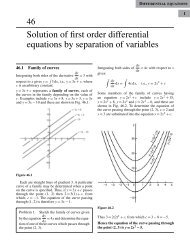vector
Create successful ePaper yourself
Turn your PDF publications into a flip-book with our unique Google optimized e-Paper software.
446 Vectors<br />
Along BC, put y = b and dy = 0 in (1) we get F . dr = (x 2 – b 2 ) dx,<br />
where x is from a to 0.<br />
F<br />
<br />
BC<br />
. dr =<br />
<br />
0<br />
3<br />
0<br />
3<br />
2 2 x 2<br />
– a 2<br />
Along CO, put x = 0 and dx = 0 in (1), we get F . dr 0<br />
( x – b ) dx – bx<br />
ba<br />
a<br />
3 3<br />
...(5)<br />
<br />
<br />
F <br />
. dr<br />
<br />
= 0 ...(6)<br />
CO<br />
Putting the values of integrals (3), (4), (5) and (6) in (2),<br />
we get<br />
<br />
<br />
F . dr =<br />
C<br />
3 3<br />
2 a 2 2<br />
a<br />
ab – ab 0 2ab<br />
...(7)<br />
3 3<br />
Now we have to evaluate R.H.S. of Stoke’s Theorem i.e.<br />
We have,<br />
F <br />
=<br />
iˆ<br />
ˆj kˆ<br />
<br />
x y z<br />
2 2<br />
x – y 2xy<br />
0<br />
<br />
S<br />
a<br />
<br />
( F).<br />
nds ˆ<br />
(2y 2 y) kˆ<br />
4ykˆ<br />
Also the unit <strong>vector</strong> normal to the surface S in outward direction is ˆn<br />
k<br />
(z-axis is normal to surface S)<br />
Also in xy-plane ds = dx dy<br />
<br />
( F). nˆ<br />
. ds = 4 ˆ. ˆ 4 .<br />
S yk kdxdy ydx dy<br />
R R<br />
Where R be the region of the surface S.<br />
Consider a strip parallel to y-axis. This strip starts on line y = 0 (i.e. x-axis) and end on the line<br />
y = b, We move this strip from x = 0 (y-axis) to x = a to cover complete region R.<br />
<br />
<br />
( F). nˆ<br />
. ds =<br />
S<br />
<br />
From (7) and (8), we get<br />
<br />
<br />
=<br />
<br />
<br />
ydy<br />
<br />
dx y dx<br />
<br />
a b 2<br />
4 <br />
a [2 ]<br />
b<br />
0 0 0<br />
0<br />
<br />
a 2 2 a 2<br />
b dx b x<br />
0<br />
ab<br />
...(8)<br />
0 2 2 [ ] 2<br />
F . dr = ( ). ˆ<br />
C F nds and hence the Stoke’s theorem is verified.<br />
S<br />
Example 99. Verify Stoke’s Theorem for the function<br />
<br />
F = xi<br />
2ˆ – xyj ˆ<br />
integrated round the square in the plane z = 0 and bounded by the lines<br />
x = 0, y = 0, x = a, y = a.<br />
Solution. We have, F = xi<br />
2ˆ – xyj ˆ<br />
<br />
F =<br />
iˆ<br />
ˆj kˆ<br />
<br />
x y z<br />
2<br />
x = 0<br />
Y<br />
y = b<br />
C<br />
B<br />
(a, b)<br />
x = a<br />
x xy 0<br />
= (0 –0) iˆ<br />
–(0–0) ˆj (– y –0) kˆ – ykˆ<br />
( ˆn to xy plane i.e. ˆk )<br />
O<br />
y = 0<br />
A<br />
X










